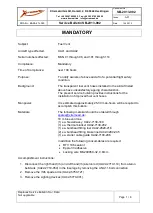
Flight manual DG-800S
4.3
Daily Inspection
Please keep in mind the importance of the inspection after rigging the
glider and respectively each day prior to the first take off. It is for your
safety.
Caution:
After a heavy landing or if other high loads have been subjected
to your sailplane, you must execute a complete inspection referring to
maintenance manual sect. 2.3 prior to the next take off.
If you detect any damage, don't operate your sailplane before the damage
is repaired. If the maintenance- and repair manual don't give adequate
information, please contact the manufacturer.
A Inspection prior to rigging
1. Wing roots and spar ends
a) check for cracks, delaminations etc.
b) check the bushes and their glued connection in the root ribs and in
the spar ends for wear
c) check the control hook ups at the rootrib for wear and corrosion
d) check the strings which hold the waterbags for sufficient tension (see
maintenance manual sect. 4.1)
e) Check the watertank compartment for water leaks
2. Fuselage at wing connection
a) check the lift pins for wear and corrosion
b) check the control hook ups including the waterdumpsystem for wear
and corrosion
3. Top of the vertical fin
a) Check the mounting points of the horizontal tailplane and the
elevator control hook up for wear and corrosion
b) Check if a battery is installed in the fin. In this case the loading chart
(section 6) must be followed.
4. Horizontal tailplane
Check the mounting points and the elevator control hook up for wear
and corrosion
5. Rigging points for the insertable wing tips (Option)
a) check the bushes and their glued connection at the inner wing panels
for wear and corrosion
b) check the lift pins and their glued connection at the insertable wing
tips for wear and corrosion, and check the securing bolt for sufficient
spring force.
Issued: April 1997 4.5
















































